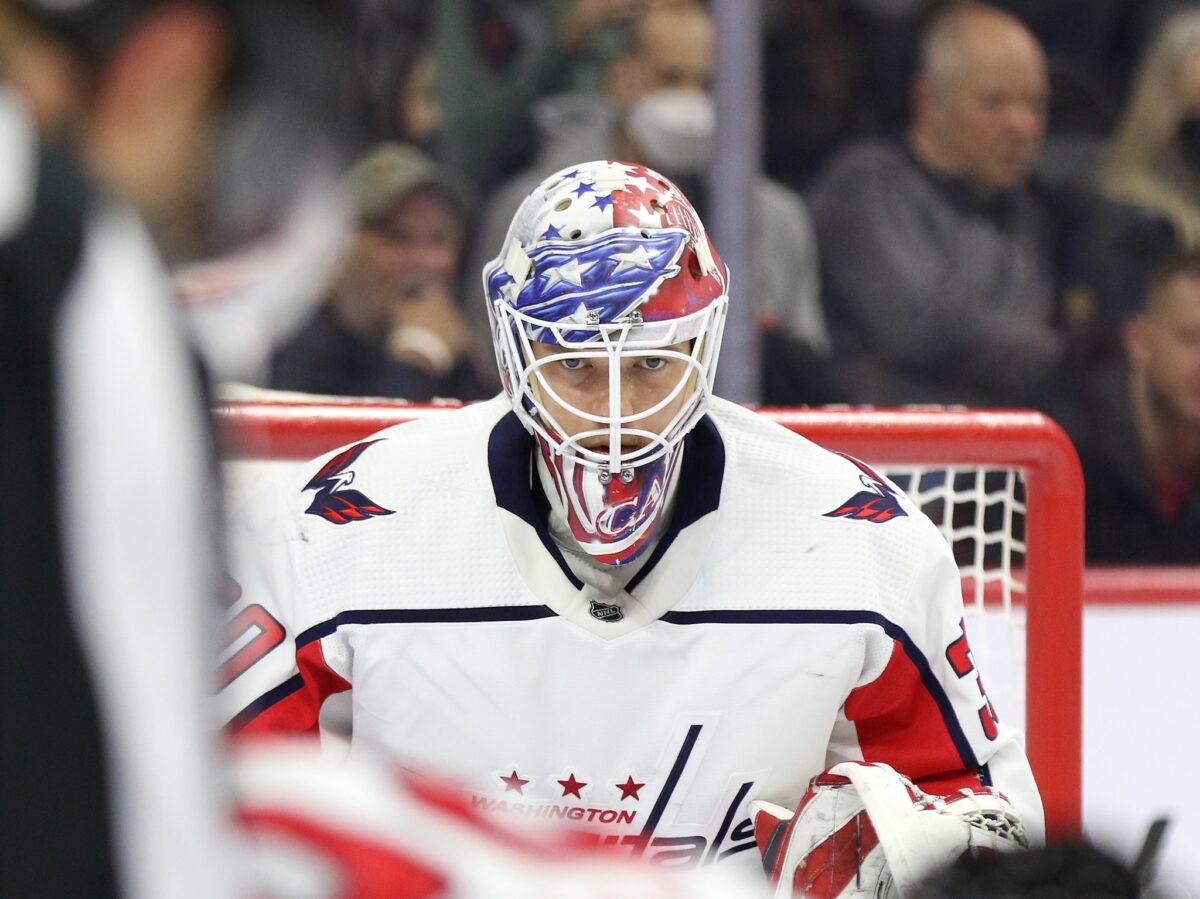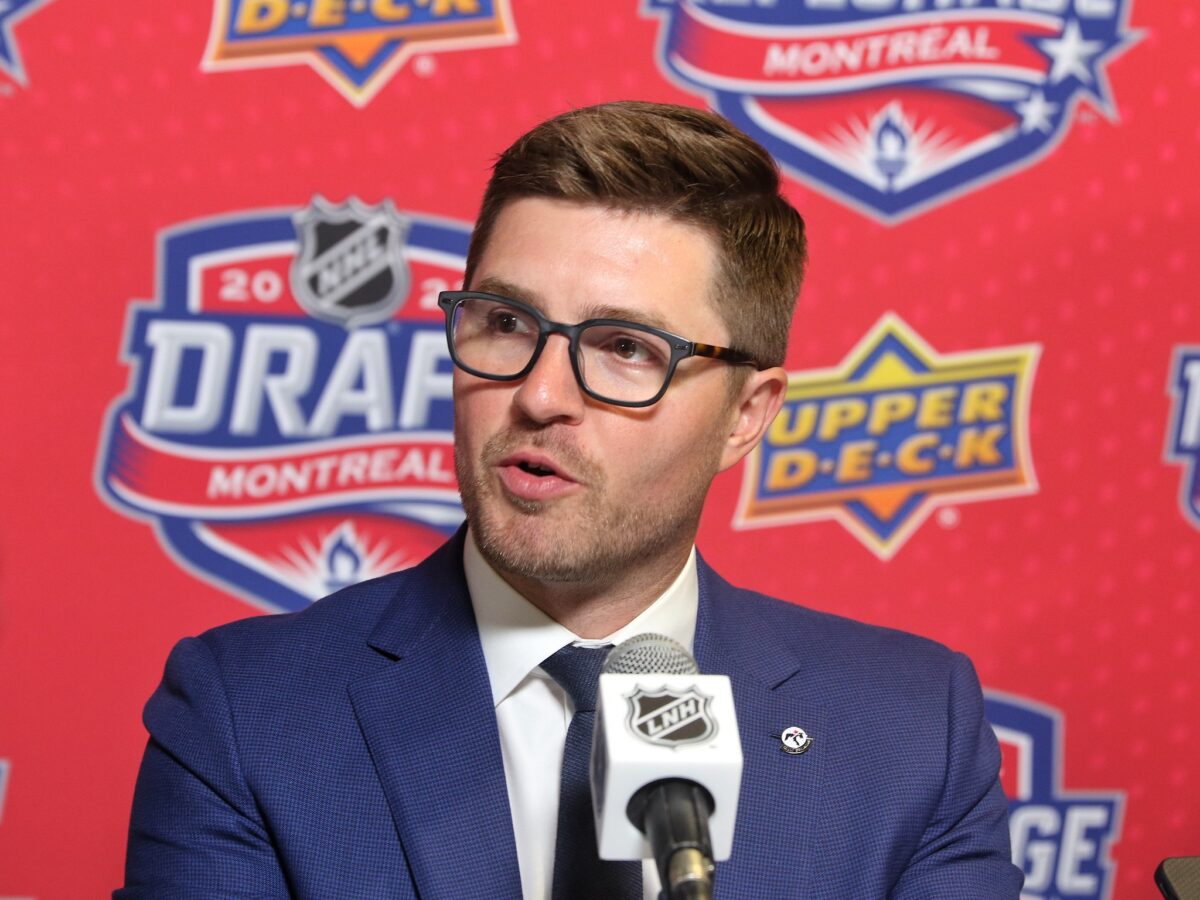The offseason is far from over, but it’s safe to say that the No. 1 headline surrounding the Toronto Maple Leafs heading into next season is the goaltending situation. After Jack Campbell left for a five-year contract with the Edmonton Oilers and Petr Mrazek was traded to the Chicago Blackhawks to unload his salary, the Maple Leafs have an entirely new-look goaltending situation heading into the 2022-23 season.
Related: Nicolas Aube-Kubel Will Be a “Hit” With the Maple Leafs
If one thing is for certain, this season’s goaltending tandem comes with a blanket of risk. The net will be split by Matt Murray, a two-time Stanley Cup Champion who’s been on a steady decline and just wrapped up a forgettable two-year tenure with the Ottawa Senators, and Ilya Samsonov, a 25 year-old former first-round pick of the Washington Capitals who also had his struggles last season.

One thing to remember is that while there’s obviously the chance that this tandem blows up in general manager Kyle Dubas’ face, there’s also the chance one of, if not both of, these goalies turn things around. Both Murray and Samsonov have tremendous upside, and they’re both going to be coming into the season with something to prove, and some extra motivation will likely stem from battling for the crease. Murray has received enough attention to last a lifetime this offseason, so we’re going to take a look at his counterpart in Samsonov, because there’s something about his contract that makes him an interesting case this season.
How Samsonov Ended Up in Toronto
As I mentioned earlier, Samsonov was a first-round pick of the Capitals in 2015. Whenever a goaltender is selected in the first round of the draft, they’re always worth paying a little extra attention to because of the variety of goalies who were first rounders. For every Carey Price and Andrei Vasilevskiy, there’s a Mark Visentin or an Al Montoya. But Samsonov was the top-ranked European goalie in the 2015 NHL Draft, and the Capitals selected him 22nd overall after an impressive season in Russia’s junior league.
Samsonov graduated to the Kontinential Hockey League (KHL) in 2015-16 and had three very impressive seasons that saw him post a save percentage (SV%) of .925 or higher and a goals-against average (GAA) of 2.35 or lower. His best season of the three was in 2016-17, where he posted a record of 15-3-5 with a GAA of 2.13 and a SV% of .936 as a 20 year-old. The Capitals brought him to North America in 2018-19 where he made his debut for the American Hockey League (AHL)’s Hershey Bears, and he made his NHL debut in 2019-20.
His rookie season was impressive, carrying a record of 16-6-2 with a GAA of 2.55 and a SV% of .913 when the season was postponed due to COVID-19. He took a slight step back in 2020-21, and then his worst season of the three came last year, where he finished with a GAA of 3.02 and a SV% of .895 to bring his record of 23-12-5 down to earth a little bit. Having reached restricted free agent (RFA) status by the end of the season, the Capitals originally planned to qualify him according to general manager Brian MacLellan. However, he had arbitration rights that could have possibly earned him a salary over $3 million next season, and they didn’t want to commit that money to him seeing how he performed in 2021-22.
To me, it’s a little bit surprising that the Capitals let Samsonov walk. I understand not wanting to pay him $3 million, but he was drafted to be their future starting goalie, and he’s still only 25 years old coming off one bad season, one decent season, and one good season in the NHL. Granted, the Capitals are $6 million over the cap right now, and re-signing him at $3 million could have both forced them to move a player to make room as well as hindered their ability to upgrade in other areas, so it sounds like a situation with no real winner.
Samsonov’s Contract Comes With Extra Value
The contract Samsonov signed with the Maple Leafs is for one year, and the value is $1.8 million. Dubas noted in his press conference that he was surprised to see the Russian netminder sign a “bet on himself” kind of contract at his age and current circumstances. Clearly, it shows that he doesn’t believe his 2021-22 season defines his abilities as a goaltender, and maybe he’d like to prove to MacLellan and the Capitals that he was worth that $3 million after all. The contract is only for one year, which essentially deems it risk-free for the Maple Leafs, at least from a long-term perspective.
On top of this, Samsonov will be 26 by the time the contract is up, which means he’ll be an RFA. This means that the Maple Leafs will hold his rights, and if another team wants to sign him, they’ll have to compensate Toronto with draft picks. It’s obviously way too early to predict how his season will go and how much he could possibly demand after next season, but let’s just say for argument’s sake that he rebounds and asks for a contract similar to that of Campbell’s. The Maple Leafs would get a first-round pick and a third-round pick should he sign for that number elsewhere and they choose not to match it. You can see the full compensation chart here.
You May Also Like
- Maple Leafs’ News & Rumours: Tavares, Robertson, & Fourth Line
- Maple Leafs’ News & Rumours: Amirov, Hildeby, & Jersey Numbers
- Maple Leafs Must Set Nick Robertson Up For Success in 2022-23
- Maple Leafs’ 2022 Offseason Trade Targets: Philadelphia Flyers
Factor in the internal competition with Murray for the crease and the fact that it’s a contract year for him, it’s entirely possible fans see a breakout year from Samsonov here. Just look at some of the other players who performed in their contract years. Nazem Kadri just had an 87-point season, shattering his former career high by 26 points. Even Ilya Mikheyev, who originally requested to be traded, scored 21 goals only a year after he struggled to even put the puck on net. Sure, these players are apples to Samsonov’s oranges since we’re comparing forwards and goalies, but it still feeds the notion that players tend to perform better in contract years when they have something to prove.
Maple Leafs Goaltending Cannot Get Worse in 2022-23
On the forefront, I can totally understand why fans are upset with Dubas’ and the Maple Leafs’ handling of the offseason so far. As much as I believe there’s untapped potential with both goalies, it’s still a big risk to commit your crease to two question marks in such a pivotal season for the franchise. But one thing that’s important to remember is that the Maple Leafs would be hard-pressed to get worse goaltending than they did last season. Campbell’s numbers were inflated by an outstanding November, and we all know how the Mrazek story went last season.

Do I think a Murray/Samsonov tandem is the answer in net this season? I don’t know. We’ll have to wait and see, and we’ll probably have a good grasp on the situation a month or so into the season. But the Maple Leafs had a team SV% of .900 in 2021-22 (and that number likely would have been lower if Campbell didn’t post a .957 SV% in November), and despite the flawed goaltending, they still finished second in the Atlantic Division and took the two-time defending Cup champions to seven games, one goal shy of never having that playoff curse conversation again. There’s intriguing upside with this tandem, and although they might not have the elite netminder fans all wanted, there’s reason to believe the team’s goaltending as a whole will be better next season.